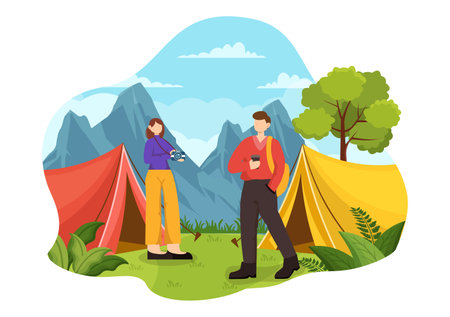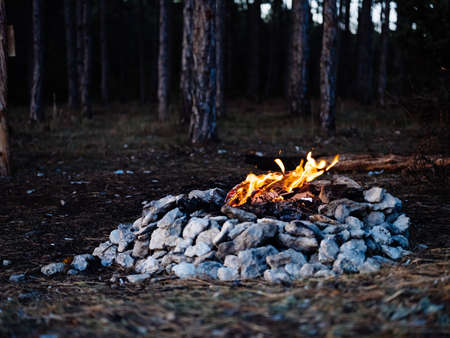1. Choosing the Right Campsite Location
Finding the perfect spot for your tent is key to a comfy night in the wild. Here’s how to make sure you’re setting up camp where you’ll sleep well and stay safe.
Scout for Flat, Dry, and Safe Ground
Always look for a level surface to pitch your tent. Sleeping on a slope means you’ll keep sliding down all night, and nobody wants to wake up in a puddle after it rains! Avoid low spots or depressions where water can pool. Check for rocks, roots, or sharp objects—clear them away so nothing pokes you through your sleeping pad.
Quick Reference: What Makes Good Ground?
| Factor | Why It Matters | Tips |
|---|---|---|
| Flatness | Keeps you from sliding or rolling at night | Avoid hills and slopes; use a sleeping pad for extra comfort |
| Dryness | Prevents soggy gear and cold nights | Stay above flood lines and away from streambeds |
| Safety | Avoids hazards like dead branches or animal trails | Look up for “widowmakers” (dead limbs), check for wildlife signs |
Think About Proximity to Water
It’s handy to camp near a water source, but not too close! Set up at least 200 feet (about 70 adult steps) from lakes, rivers, or streams. This keeps your campsite dry and protects sensitive plants along the banks. Plus, it helps you follow Leave No Trace principles by minimizing your impact on the area.
Watch Out for Wind Exposure
Strong winds can flatten tents and make it tough to sleep. If possible, find natural windbreaks like bushes, trees (make sure they’re healthy!), or boulders. Face your tent door away from the prevailing wind direction for extra protection.
Respect Leave No Trace Principles
Always choose established sites when possible to reduce your impact on the environment. Avoid expanding existing campsites, and never clear new ground unnecessarily. Remember: “Take only pictures, leave only footprints.” Respect wildlife by keeping food secure and following local guidelines for waste disposal.
2. Sleeping Gear: Pads, Bags, and Pillows
Choosing the Right Sleeping Pad
When it comes to campsite comfort, a good sleeping pad is your first line of defense against cold, hard ground. American campers often choose from three main types:
| Type | Pros | Cons |
|---|---|---|
| Foam Pads | Lightweight, durable, affordable | Bulky, less cushion |
| Self-Inflating Pads | Good balance of comfort and packability | Heavier than foam, can puncture |
| Air Pads | Very comfortable, compact when packed | Can be noisy, risk of leaks or punctures |
Selecting a Sleeping Bag by Temperature Rating
The U.S. has diverse climates, so picking a sleeping bag rated for the right temperature is crucial. Most bags are labeled with a temperature rating—this tells you the lowest temp at which you’ll stay warm. Here’s a quick guide:
| Season/Use | Temp Rating (°F) | Common Features |
|---|---|---|
| Summer Camping | 35°F and above | Lighter weight, more ventilation options |
| Three-Season Camping | 20–35°F | Mummy shape for warmth, draft tubes, hooded designs |
| Winter Camping/High Elevation | 20°F and below | Extra insulation, water-resistant shell materials |
Synthetic vs Down Insulation in Sleeping Bags
Synthetic bags: More affordable, perform better when wet.
Down bags: Lighter and more compressible but pricier and lose warmth if they get soaked.
Pillows and Comfort Accessories Popular Among American Campers
- Camping Pillows: Inflatable or compressible pillows are lightweight and easy to pack. Some folks bring their favorite pillow from home for extra comfort.
- Liners: Add warmth and keep your sleeping bag cleaner for longer.
- Cots: For car camping or basecamps, cots lift you off the ground for even more comfort.
- Blankets: Packable down blankets are great for chilly nights or around the campfire.
- Hot Water Bottles: Fill one up before bed and tuck it into your sleeping bag for added warmth on cold nights—a classic American camper trick!

3. Tent Setup for Maximum Comfort
Best Practices for Pitching Your Tent
Setting up your tent right is key to a good nights sleep in the wild. First, pick a flat, dry spot thats slightly elevated to avoid puddles if it rains. Look for natural windbreaks like trees or bushes, but steer clear of dead branches above (known as “widowmakers”). Lay down a ground tarp (footprint) before pitching your tent—this adds insulation and protects your tent floor from moisture and sharp objects. Stake out all corners and use guy lines to secure the tent, especially if windy weather is expected.
Managing Condensation
Condensation can make your sleeping space damp and uncomfortable. Here are some classic American camping hacks to keep things dry:
| Hack | How It Helps |
|---|---|
| Ventilation | Open vents or crack doors/windows to allow airflow, reducing moisture buildup. |
| Avoid Wet Gear Inside | Leave wet shoes and clothes outside or in the vestibule to keep interior dry. |
| Use a Small Towel | Bring a microfiber towel to wipe down inner walls if condensation forms overnight. |
Creating a Cozy Sleeping Space: US Camping Hacks
Nothing beats crawling into a warm, cozy tent after a long day outdoors. Try these simple tips used by seasoned American campers:
- Layer Up Your Sleep System: Use an insulated sleeping pad or two (foam + inflatable) for comfort and warmth. Top with your sleeping bag rated for local nighttime temps, and add a fleece liner if you get cold easily.
- Pillow Hack: Stuff extra clothes into a soft bag or use an inflatable pillow for neck support—no more bunched-up hoodies!
- Organize Essentials: Keep a headlamp, water bottle, and snacks within reach using mesh pockets or hanging organizers in your tent.
- Add Homey Touches: Bring along a favorite blanket or lightweight camp quilt for extra comfort on chilly nights.
- Campsite Rugs: Place an old doormat or small rug just inside the entrance to keep dirt out and create a “homey” feel underfoot.
Packing List for Tent Comfort
| Item | Why Its Useful |
|---|---|
| Tent footprint/tarp | Keeps you dry and protects the tent floor. |
| Sleeping pad(s) | Adds insulation and softness. |
| Pillow/inflatable pillow | Makes sleeping more comfortable. |
| Fleece liner/blanket | Adds warmth and homey comfort. |
| Campsite rug/mat | Keeps feet clean and adds coziness. |
| Microfiber towel | Drys off any condensation quickly. |
| Organizer pockets/hanging gear lofts | Keeps essentials handy at night. |
With the right setup, you’ll be ready to enjoy restful nights under the stars—just like at home, only wilder!
4. Staying Warm and Dry All Night
Strategies for Insulation
Staying cozy in your tent starts with the right insulation. A quality sleeping pad not only gives you comfort but also prevents heat loss to the cold ground. Foam pads, inflatable pads, or a combination of both can work wonders. In colder climates like the Rockies or Sierras, look for pads with higher R-values for better thermal protection.
Layering for Comfort
Dressing in layers is key to regulating your body temperature through the night. Start with moisture-wicking base layers—these pull sweat away from your skin, keeping you dry. Add an insulating mid-layer, like a fleece or puffy jacket, and top it off with a lightweight shell if its damp or windy inside your tent.
Recommended Layering System
| Layer | Purpose | Example Gear (US Brands) |
|---|---|---|
| Base Layer | Wicks moisture from skin | Patagonia Capilene, REI Co-op Merino Wool |
| Mid Layer | Traps body heat | The North Face Fleece, Outdoor Research Grid Hoodie |
| Outer Layer | Blocks wind & rain | Arcteryx Beta Jacket, Columbia Rain Shell |
Moisture Control Tips
Avoid waking up clammy by managing condensation and humidity inside your tent. Ventilate by cracking windows or vents slightly—even in chilly weather—to allow airflow. Store wet gear outside the sleeping area and avoid breathing directly into your sleeping bag hood, as this adds unwanted moisture.
Using Local Outdoor Gear Brands for Comfort
American outdoor brands are experts at designing gear for the country’s varied climates. Consider using:
- NEMO Equipment: Known for innovative sleeping pads and bags designed for warmth and comfort.
- Klymit: Offers lightweight, compact sleeping pads ideal for backpackers.
- Therm-a-Rest: Classic choice for reliable and insulating sleep systems.
- Big Agnes: Famous for roomy tents and integrated sleep systems that keep you snug all night.
Your Campsite Checklist for a Restful Night
- Select a flat, dry spot for your tent setup.
- Use a footprint or ground cloth to prevent ground moisture from seeping in.
- Pile extra clothes at your feet inside your sleeping bag for added warmth.
- Tuck a warm water bottle into your bag on chilly nights—but make sure it’s tightly sealed!
Smooth out these details before dusk so you can settle in and enjoy deep sleep under the stars.
5. Personalizing Your Sleeping Arrangements
Make It Feel Like Home: Creative Comfort Hacks
Campsite comfort is all about making your sleeping spot feel as cozy and familiar as possible. In the US, campers have come up with lots of clever ways to turn a tent or hammock into a restful retreat. Think soft bedding, favorite nighttime snacks, and bedtime routines that make you feel at ease even miles away from home.
Popular Camper Bedtime Routines
| Routine | Description |
|---|---|
| Pillow from Home | Bringing your regular pillow helps you settle in quickly and sleep better under the stars. |
| Favorite Blanket or Sleeping Bag Liner | Adding a fleece liner or a well-loved blanket gives extra warmth and comfort. |
| Reading by Headlamp | A quick chapter from a book or listening to an audiobook can help you wind down after a busy day outdoors. |
| Lavender Spray or Essential Oils | A light spritz on your pillow brings calming scents and a touch of homey luxury to your tent. |
| Changing into Camp Pajamas | Dedicating clean, comfy clothes just for sleeping signals your body it’s time for rest. |
Favorite Snacks for a Good Night’s Rest
| Snack | Why Campers Love It |
|---|---|
| S’mores (with Dark Chocolate) | This classic treat isn’t just delicious—it’s comforting and part of the American campfire tradition. |
| Trail Mix with Nuts & Dried Fruit | A handful before bed keeps hunger at bay and provides lasting energy through the night. |
| Instant Oatmeal Packets | Warm, easy to make, and soothing on chilly nights. |
| Hot Cocoa or Herbal Tea | Sipping something warm helps your body relax and get ready for sleep. |
| Granola Bars | No mess, no fuss—just quick comfort if you get peckish before bed. |
Campfire Wind-Down Rituals in the US
The campfire isn’t just for cooking—it’s also where many campers slow down and prepare for sleep. Here are some favorite ways Americans use the fire to wind down:
- Telling Stories: Classic ghost stories or sharing memories with friends sets a cozy mood before bed.
- Singing Songs: Even simple tunes around the fire can relax everyone and bring out those good camping vibes.
- Meditation or Stargazing: A few quiet moments watching the stars or focusing on the sounds of nature can help clear your mind before you hit the sack.
- S’mores Time: Roasting marshmallows signals that it’s almost time to wrap up the day—and is a sweet way to end it!
- Candle Lanterns: Hanging small lanterns adds gentle light and makes any tent site feel special at bedtime.


